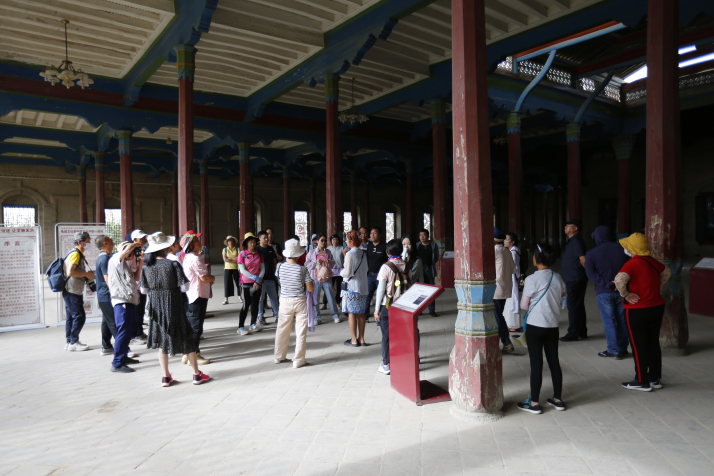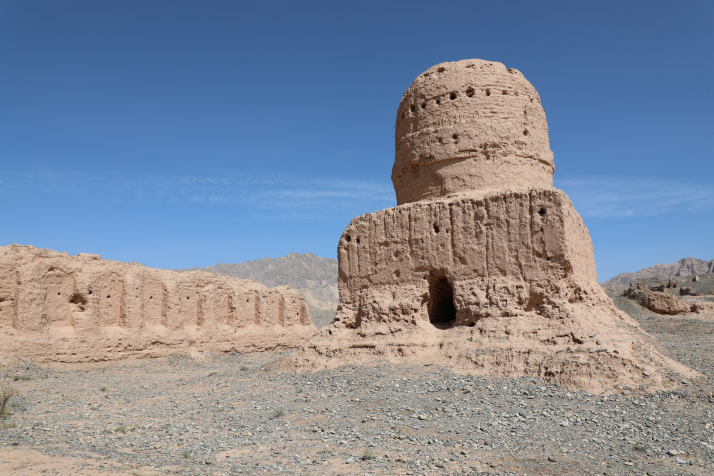| Xinjiang Today |
| A tapestry of religions | |
|
|
 Tourists visit the Kuche Mosque in Kuche in June 2023 (VCG)
The archaeological excavation of the Mo'er Temple ruins, located approximately 30 km northeast of downtown Kashi (Kashgar) City, has revealed the flourishing spread of Buddhism in what is now Xinjiang over 1,900 years ago. This temple, which dates back to the first century, is not only a treasure of Buddhist culture but also a microcosm of the diverse cultural exchanges that were occurring along the ancient Silk Road.
The temple is typical of large-scale, ground-level Buddhist temples built in China at the time, and its excavation has provided a sample of the layout and evolution of Buddhist temples built during the early period of Buddhism's introduction. There are many religious ruins in Xinjiang such as the Xipang Jingjiao monastery site, a Nestorian church ruin on the west side of Turpan City. Nestorianism, or Jingjiao as it was known in China, is a branch of Christianity that originated in the Sasanian Empire (an ancient Iranian dynasty) in the fifth century. Ten years ago, the Institute of Archaeology of the Chinese Academy of Social Sciences discovered the Jirzankale Cemetery on a terrace in Tashikuergan (Taxkorgan or Tashkurgan) Tajik Autonomous County in Kashi Prefecture. The surrounding area was regularly paved with alternating black and white radial stone strips. It is the best-preserved and largest Zoroastrian (or Xianjiao) ruin discovered in China to date. Zoroastrianism, which worships fire, is one of the world's oldest monotheistic religions originating in ancient Persia, modern-day Iran.  The Subash Buddhist ruins in Kuche (Kuqa), Aksu Prefecture, date back to the third century (VCG)
Multiple religions When people talk about religion in Xinjiang, many immediately think of Islam. However, these religious ruins in Xinjiang demonstrate that many religions coexisted, spread and developed here before the introduction of Islam. Archaeological and historical data indicate that before the fourth century B.C., primitive religions, such as nature worship and totem worship, were prevalent in Xinjiang. Even today, many ethnic groups in Xinjiang retain, to varying degrees, the concepts and customs of primitive religions. For example, the Water Festival, the custom of worshiping the moon, and folk customs like hanging flags and sheepskins are all related to primitive religions. Around the first century B.C., Buddhism began to spread into Xinjiang, reaching its peak from the fourth to the 10th centuries. During the same period, Zoroastrianism was prevalent throughout Xinjiang. Taoism was introduced to Xinjiang around the fifth century, mainly flourishing in Turpan and Hami, and then spread to most parts of Xinjiang during the Qing Dynasty (1644-1911). Manichaeism, another religion of the Sasanian Empire, and Nestorianism were successively introduced to Xinjiang in the sixth century. In the late ninth and early 10th centuries, the Kara-Khanid Khanate emerged in the Kashi region. While Kashi was one of the first parts of China to embrace Buddhism, the Kara-Khanid Khanate accepted Islam. Due to the emergence of the Kara-Khanid Khanate, Kashi became the origin point for the spread of Islam in Xinjiang. In the mid-10th century, the Kara-Khanid Khanate launched a religious war lasting over 40 years against the Kingdom of Khotan, another local regime that adopted Buddhism. In early 11th century, they conquered Khotan, forcefully promoting Islam and ending over 1,000 years of Buddhist history in the region. With the continuous spread of Islam, religions such as Zoroastrianism, Manichaeism and Nestorianism gradually declined. In the mid-14th century, rulers of the Eastern Chagatai Khanate in the Mongolian regions of China gradually promoted Islam through warfare and other coercive means to the northern edge of the Tarim Basin, the Turpan Basin and the Hami area in what is now Xinjiang. By the 16th century, religions like Zoroastrianism, Manichaeism and Nestorianism gradually disappeared, while Buddhism and Taoism survived. Around the 18th century, Christianity, including Catholicism and Eastern Orthodoxy, were successively introduced to Xinjiang. Xinjiang's religious landscape has undergone a long historical evolution, ultimately forming its current composition of Islam, Buddhism, Taoism, Protestantism, Catholicism and Eastern Orthodoxy. Despite the historical vicissitudes, the pattern of multiple religions coexisting remains a major characteristic of Xinjiang's religious landscape. Islam is not the only religion believed in by Uygurs. Archaeological discoveries from burial ruins in various parts of Xinjiang show that early Uygur societies adhered to primitive religions. For example, some burial ruins contained sacrificial artifacts, such as divine poles for worshipping heaven and sacrificial offerings, which are manifestations of the worship of nature deities in primitive religions. Later, Uygurs successively believed in Zoroastrianism, Buddhism, Manichaeism, Nestorianism and Islam. During the Tang and Song dynasties (618-1279), in the Uygur Kingdom of Gaochang and the Kingdom of Khotan, Buddhism was widely practiced by people from the royalty and nobility down to the common populace. In the Yuan Dynasty (1279-1368), a large number of Uygurs converted to Nestorianism. From a historical perspective, the introduction of Islam to the Xinjiang region is related to the rise of the Arab Empire and the eastward expansion of Islam. The Uygurs' adoption of Islam was not a voluntary conversion and transformation by the local populace at the time, but rather the result of religious wars and the forceful promotion by the ruling classes. While this coercion does not diminish the right of Uygur people to practice Islam today, it is a historical fact. Islam is neither a religion that the Uygur people were born into nor their only religion. In the process of accepting Islam, the ancestors of the ethnic groups in Xinjiang, such as the Uygurs and Kazaks, both retained their original beliefs and cultural traditions and absorbed cultures from other ethnic groups in Xinjiang and from other parts of China. Some original religious concepts, rituals, and customs evolved and persisted, influencing each other and gradually forming a distinctive Xinjiang form of Islam with strong regional and ethnic characteristics. For example, Islam originally prohibits the worship of anyone or anything other than Allah, but ethnic groups like the Uygurs still practice Mazar worship, the veneration of tombs or shrines of Islamic saints, revered figures, or local spiritual leaders, and customs such as erecting tall poles, hanging flags, and suspending sheepskins at Mazars, which are remnants of diverse religions like Shamanism and Buddhism. Furthermore, some Uygur people in Xinjiang adhere to other religions, and many do not believe in any religion. Therefore, equating the Uygur people with Islam, or Xinjiang with Islam, is stereotypical and incorrect.  An exhibition in the Turpan Museum shows how Buddhism and Taoism spread in Xinjiang (VCG)
Freedom of religious belief Historically, religious relations in Xinjiang were highly complex. Before the founding of People's Republic of China in 1949, there were multiple conflicts between different religions and between different denominations within the same religion, with some areas even experiencing religious wars lasting for decades and sectarian disputes lasting for centuries. Religious wars and conflicts not only caused severe damage to the economy and society but also brought profound suffering to the people. After the founding of the People's Republic of China in 1949, all ethnic groups in Xinjiang gained the right to freedom of religious belief. The Central Government and local governments at all levels in Xinjiang have continuously improved laws and regulations for the administration of religious affairs. Xinjiang's various religions have entered a new stage of harmonious coexistence. Like most countries in the world, China adheres to the principle of separation of church and state. No religion may interfere with politics. No one may use religion to obstruct normal social order, work order or daily life. No one may use religion to oppose the socialist system, or to undermine ethnic and national unity. Xinjiang implements the constitutional principle of freedom of religious belief, respecting both the freedom to believe in a religion and the freedom not to believe in a religion. It does not allow the creation of disputes between believers and non-believers, between those who believe in one religion and those who believe in another, or between followers of different denominations. Xinjiang adheres to the principle of equality among all religions, treating all religions equally, neither favoring nor discriminating against any religion. No religion may enjoy a special status above others. Comments to lanxinzhen@cicgamericas.com |
|
||||||||||||||||||||||||||||
|